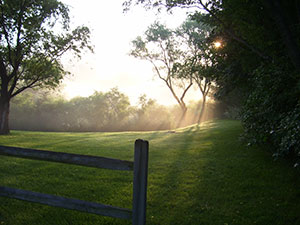California’s Drought Crisis
Water restrictions are a necessity, but eliminating lawns altogether could create unforeseen environmental consequences.
The water crisis in California is extremely serious, so serious, in fact, that Gov. Jerry Brown issued an executive order earlier this month mandating a 25 percent reduction in water usage across the state compared with 2013 levels.
Everyone agrees that California’s water crisis calls for restrictions and sound water conservation practices, but are turfgrass replacement and elimination programs really the answer? Might this trade-off have consequences down the road?
April is National Lawn Care Month, and it presents an opportunity to address the many environmental benefits that lawns and turfgrass have to offer that are often overlooked or of which the public is unaware. Among these benefits are those that could help to mitigate the negative impacts of droughts, including turfgrass reducing storm water runoff — thus protecting the potable water supply — and capturing and filtering precipitation so it can be reintroduced into the water supply.
Turfgrass offers additional benefits that can help to prevent or lessen the severity of future droughts, such as cooling the air, producing oxygen, reducing pollution, capturing and suppressing dust, controlling soil erosion, retaining and sequestering carbon, assisting in the decomposition of pollutants, restoring soil quality, dissipating heat, lowering allergy related problems, reducing home cooling costs, serving as a fire barrier, etc.
The problem isn’t that we have lawns, the problem is how we care for our lawns. In general, people overwater their lawns because they think if their lawn isn’t green, it may be dying, when in fact grass goes into a dormant state during a drought and needs a minimal amount of water to survive. Grass is able to sustain itself even though it goes dormant, as long as the crowns and the root system are preserved and have adequate moisture to sustain themselves.
A healthy established lawn can do surprisingly well during the hot summer season and during lengthy dry periods. In fact, grass shuts down when the temperature reaches 95 to 98 F (35 to 37 C), allowing the plant to go into a cooling-down process. During the hotter months of the year, an established lawn can do fine with as little as a half inch of water per week and, depending on the species, even less.
Can water conservation and lawns co-exist? They must, if California and other regions of the country impacted by the drought want to prevent potential heat islands, serious erosion concerns, storm water runoff problems and other consequences in the foreseeable future.
Encouraging the removal of lawns from the landscape in an effort to accomplish a quick fix could have severe repercussions down the road and everyone should consider the long term consequences of such measures before things really begin to heat up.












How about addressing the massive depletion on water resources caused by unbridled illegal alien entry?
Too politically correct? Oh,I forgot, many in the landscape industry look the other way, profit being more important than sovereignty.